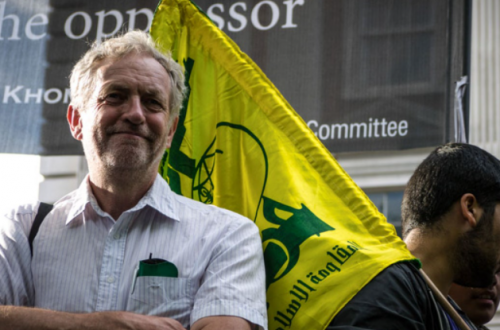Cross-posted from Dave Rich at the CST blog
The appalling and tragic events in Norway on Friday have served as an horrific reminder that Europe’s far right is capable of producing terrorists, who are just as willing to kill in large numbers as any jihadi terrorist group.
Previously, most attempts by neo-Nazis or other adherents of far right ideologies to perpetrate terrorist attacks have failed for logistical reasons, but there are enough examples that succeeded – for example, David Copeland here in the UK, or the 1995 Oklahoma City bombing in the United States – to dispel any complacency. The growing list of prosecutions and convictions in Britain of would-be terrorists from the far right in recent years shows that this is a real and growing problem.
CST’s Michael Whine has authored a chapter on the trans-European links of far right extremists for a forthcoming book, Mapping the Extreme Right in Contemporary Europe (Berghahn Books, forthcoming). The section of this chapter which addresses far right terrorism is worth repeating here, in particular noting the escalation from street violence to terrorism, and the focus on the Muslims and the state as preferred targets for violence:
Street violence has always been part of the neo-Nazi scene: it provides a focus for hatred and thereby draws in new adherents, but the emerging trend involves a move beyond the anti-foreigner street violence of the 1990s towards a more focused violence, which includes terrorism, and which is spurred by different reasons (Merkl 1997: 17).
Tore Bjorgo noted in 1995 that the increasing support for xenophobic and radical-right parties enabled the growth of militant neo-Nazi organizations and networks which targeted asylum seekers and visible minorities within Europe. He further observed that groups perceived as ‘right wing’ or ‘racist’ often turned out to have no connections with extreme political organizations, and only a rudimentary idea of any ideology. He suggested that defining the essence of right-wing extremism in terms of one single issue, value or philosophical idea would prove to be a frustrating exercise. Rather, he suggested, that theirs ‘is an anger against perceived outsiders, or the state, which could take a violent path’ (Bjorgo 1995: 2).
At the same time, the late Ehud Sprinzak suggested that violent, extreme right-wing groups are organized around the belief that the object of their intense opposition is a priori illegitimate, that they do not belong to the same humanity as themselves, and should therefore be kept in an inferior legal state, expelled or even eliminated. He further observed that their violence may be directed towards the ‘inferior’ group, or it may be directed against the political authority which has allowed such a situation to develop (Bjorgo 1995: 4).
Evidence in recent criminal trials and security services’ reports suggests that elements within the extreme right are preparing and training for what they perceive to be a coming war for ‘white survival’. Few criminal justice agencies publish data on this specifically, or differentiate it from other forms of violent crime, but the exceptions are the Swedish and German security services (BfV various years; SAPO various years; for background, see Bjorgo 1995). Their reports note that within established extreme-right bodies there are now individuals, or small groups, who are planning and preparing for acts of terrorism using firearms and improvized explosive devices that are more sophisticated than petrol bombs or other forms of missile previously associated with extreme-right violence. This new trend stands in stark contrast to earlier perceptions when several European security services reported an ambivalence towards the use of violence.
The move to terrorism is not perceived to be a substantive challenge to the state, but rather an attack on symbols of the state and a reaction to the influx of migrants, particularly Muslims. In Sweden, for example, four neo-Nazis were charged in early 2005 in connection with a terrorist plot to attack the parliament building and schools, but for evidentiary reasons were convicted only of causing criminal damage (SAPO 2005: 5). The Swedish security police therefore noted in 2006 that
[ext]Both the White Power scene and the autonomous scene contain actors who have shown that they are prepared to use threat, violence or force to attain their political objectives. In some cases their actions are directed against authorities or political parties represented in parliament (SAPO 2006: 23).
This new trend is neither widespread nor does it involve large numbers, but is the consequence of a small minority acting out their extreme ideology. It is, however, planned and coordinated at a national and an international level, and it is the Internet that enables and strengthens the processes. A Europol report noted in 2006 that
[ext]Although violent acts perpetrated by right-wing extremists and terrorists may appear sporadic and situational, right-wing extremist activities are organised and transnational (Europol 2007, p.4).
The inspiration for many is the ‘leaderless resistance’ model of small cells or single individuals (‘lone wolves’) using terror tactics to resist central government suggested by U.S. extreme-right theoretician Louis Beam, and the messages contained in The Turner Diaries and Hunter, two novels written by William Pierce, under the pseudonym of Andrew Macdonald. The former depicts a violent revolution to overthrow the U.S. federal government and to exterminate Jews and non-whites; the latter describes a targeted assassination campaign of couples in inter-racial marriages and civil rights activists carried out by a Vietnam War veteran who is drawn into a white nationalist group planning insurrection (Beam 1992; Macdonald (1978, 1989).
The murder of Theo van Gogh, and the 7 July London bombings galvanized neo-Nazi groups around Europe although the immediate reaction did not lead to the extreme violence that security agencies predicted. There was, however, an increase in low-level violence, and anti-Muslim demonstrations in many countries, especially in the Netherlands and the U.K. The Dutch security service and the annual Dutch Racism and Extremism Monitor both reported a discernible move by activists to ‘tougher, violence-prone neo-Nazi groups’ which are ‘just a fraction removed from terrorism’ (AIVD 2005, 2006, 2007; van Donselaar and Rodrigues 2006). The acquisition of arms, bomb-making materials and military manuals has been noted in several states, although the degree to which they will use them is another matter, and their possession may be more apparent than their willingness and capability to deploy them. During April and July 2005, the German authorities confiscated large caches of arms and explosives in raids on the homes of neo-Nazis, but commented afterwards that the intention appeared to have been to stockpile arms rather than use them immediately. They also noted that some right-wing extremists reject terrorist activity which could lead to increased surveillance by the state (BfV 2005: 50). In the U.K., the police also foiled a succession of terrorist plots initiated by extreme-right activists. Nevertheless, the German authorities report that extreme-right activists are increasingly prepared to resort to violence, to obtain weapons and to engage in paramilitary exercises, as training for terrorism (BfV 2004: 39–41; BfV 2005: 49–50).
The willingness to employ extreme violence in defence of European ‘values’ is apparent in the ideology of several groups, among them the British Patriots of the White European Resistance (POWER), which emerged in 2006, and which claims supporters in Croatia, Netherlands, Norway, Poland, Serbia, Switzerland, Slovenia and Sweden. The British police have reported
[ext]There is no intelligence to suggest that POWER is instrumental in influencing known or alleged ‘Lone Wolf’ operatives. However POWER is a relatively new group who are difficult to regionalise and who have links to continental Europe (Association of Chief Police Officers 2008).
The POWER website states that
[ext]We began in Great Britain but are a pro European movement with members in all European countries … We were formed as a last chance movement to preserve our individual nations and to unify Europe and build the great nations and Europe we once had … We are not a Political party, and would consider ourselves freedom fighters, not the left wing version of the term freedom fighters. Which are called Terrorists, we are defenders of the European culture. However we urge people to support National Socialism … We are firm believers in the policies of Oswald Mosley and strongly support all of his theories on the state of Europe (http://www.14power88.com/vonherman/vwar/page.php?id=6).
POWER identification of the enemy is shared with like-minded groups:
[ext]The western world we feel is under threat from not only Jewish corruption but also from mass immigration, drug imports, religious divide, gun crime, Islamic hatred and multiculturalism in general, we firmly support all of Europe but refuse to accept that we owe any African anything … We stand alongside every European nation that wishes to remove non whites from their land (http://www.14power88.com/vonherman/vwar/page.php?id=6).
The Racial Volunteer Force (RVF) is a second trans-European group which emerged from the UK-based Combat 18, with branches in the UK, Germany, Belgium and the Netherlands, and which declares itself to be an international ‘militant Pro White Organisation’, with its own European council. It hints that it will resort to violence and warns its members that they must think long and hard before joining (http://wwwrvfonline.com/house.htm). The Dutch security service identified its members as ‘strongly ideologically developed’ capable of playing an important role in furthering and cementing contacts (AIVD 2006: 52). The terrorist threat is not perceived to be a substantive challenge to the state, but rather an attack on the symbols of the state and a reaction to the influx of migrants, particularly Muslims. It is not a widespread trend, nor is it coordinated and planned at any central point. Rather, it is the consequence of small groups acting out their extreme ideology.
The 2008 Europol report on terrorist threats within the European Union identified an increasing number of extreme-right terrorist plots in the U.K. during the past ten years by individuals classified as ‘lone wolves’ who share ‘an ideological or philosophical identification with an extremist group, but do not communicate with the group they identify with’ (Europol 2008: 39). They follow the models proposed by Beam and Pierce.
Street violence has always been part of the neo-Nazi scene: it provides a focus for hatred and thereby draws in new adherents, but the emerging trend involves a move beyond the anti-foreigner street violence of the 1990s towards a more focused violence, which includes terrorism, and which is spurred by different reasons.
Tore Bjorgo noted in 1995 that the increasing support for xenophobic and radical-right parties enabled the growth of militant neo-Nazi organizations and networks which targeted asylum seekers and visible minorities within Europe. He further observed that groups perceived as ‘right wing’ or ‘racist’ often turned out to have no connections with extreme political organizations, and only a rudimentary idea of any ideology. He suggested that defining the essence of right-wing extremism in terms of one single issue, value or philosophical idea would prove to be a frustrating exercise. Rather, he suggested, that theirs ‘is an anger against perceived outsiders, or the state, which could take a violent path’.
At the same time, the late Ehud Sprinzak suggested that violent, extreme right-wing groups are organized around the belief that the object of their intense opposition is a priori illegitimate, that they do not belong to the same humanity as themselves, and should therefore be kept in an inferior legal state, expelled or even eliminated. He further observed that their violence may be directed towards the ‘inferior’ group, or it may be directed against the political authority which has allowed such a situation to develop.
Evidence in recent criminal trials and security services’ reports suggests that elements within the extreme right are preparing and training for what they perceive to be a coming war for ‘white survival’. Few criminal justice agencies publish data on this specifically, or differentiate it from other forms of violent crime, but the exceptions are the Swedish and German security services (BfV various years; SAPO various years; for background, see Bjorgo 1995). Their reports note that within established extreme-right bodies there are now individuals, or small groups, who are planning and preparing for acts of terrorism using firearms and improvized explosive devices that are more sophisticated than petrol bombs or other forms of missile previously associated with extreme-right violence. This new trend stands in stark contrast to earlier perceptions when several European security services reported an ambivalence towards the use of violence.
The move to terrorism is not perceived to be a substantive challenge to the state, but rather an attack on symbols of the state and a reaction to the influx of migrants, particularly Muslims. In Sweden, for example, four neo-Nazis were charged in early 2005 in connection with a terrorist plot to attack the parliament building and schools, but for evidentiary reasons were convicted only of causing criminal damage (SAPO 2005: 5). The Swedish security police therefore noted in 2006 that
Both the White Power scene and the autonomous scene contain actors who have shown that they are prepared to use threat, violence or force to attain their political objectives. In some cases their actions are directed against authorities or political parties represented in parliament (SAPO 2006: 23).
This new trend is neither widespread nor does it involve large numbers, but is the consequence of a small minority acting out their extreme ideology. It is, however, planned and coordinated at a national and an international level, and it is the Internet that enables and strengthens the processes. A Europol report noted in 2006 that
[ext]Although violent acts perpetrated by right-wing extremists and terrorists may appear sporadic and situational, right-wing extremist activities are organised and transnational (Europol 2007, p.4).
The inspiration for many is the ‘leaderless resistance’ model of small cells or single individuals (‘lone wolves’) using terror tactics to resist central government suggested by U.S. extreme-right theoretician Louis Beam, and the messages contained in The Turner Diaries and Hunter, two novels written by William Pierce, under the pseudonym of Andrew Macdonald. The former depicts a violent revolution to overthrow the U.S. federal government and to exterminate Jews and non-whites; the latter describes a targeted assassination campaign of couples in inter-racial marriages and civil rights activists carried out by a Vietnam War veteran who is drawn into a white nationalist group planning insurrection.
The murder of Theo van Gogh, and the 7 July London bombings galvanized neo-Nazi groups around Europe although the immediate reaction did not lead to the extreme violence that security agencies predicted. There was, however, an increase in low-level violence, and anti-Muslim demonstrations in many countries, especially in the Netherlands and the U.K. The Dutch security service and the annual Dutch Racism and Extremism Monitor both reported a discernible move by activists to ‘tougher, violence-prone neo-Nazi groups’ which are ‘just a fraction removed from terrorism’ (AIVD 2005, 2006, 2007; van Donselaar and Rodrigues 2006). The acquisition of arms, bomb-making materials and military manuals has been noted in several states, although the degree to which they will use them is another matter, and their possession may be more apparent than their willingness and capability to deploy them. During April and July 2005, the German authorities confiscated large caches of arms and explosives in raids on the homes of neo-Nazis, but commented afterwards that the intention appeared to have been to stockpile arms rather than use them immediately. They also noted that some right-wing extremists reject terrorist activity which could lead to increased surveillance by the state (BfV 2005: 50). In the U.K., the police also foiled a succession of terrorist plots initiated by extreme-right activists. Nevertheless, the German authorities report that extreme-right activists are increasingly prepared to resort to violence, to obtain weapons and to engage in paramilitary exercises, as training for terrorism (BfV 2004: 39–41; BfV 2005: 49–50).
The willingness to employ extreme violence in defence of European ‘values’ is apparent in the ideology of several groups, among them the British Patriots of the White European Resistance (POWER), which emerged in 2006, and which claims supporters in Croatia, Netherlands, Norway, Poland, Serbia, Switzerland, Slovenia and Sweden.
[…]
The 2008 Europol report on terrorist threats within the European Union identified an increasing number of extreme-right terrorist plots in the U.K. during the past ten years by individuals classified as ‘lone wolves’ who share ‘an ideological or philosophical identification with an extremist group, but do not communicate with the group they identify with’ (Europol 2008: 39). They follow the models proposed by Beam and Pierce.
These trends have been apparent for some years. In 2001, just prior to the 9/11 attacks, Michael Whine wrote another paper about two new types of terrorism: far right terrorism and religious terrorism. Both types of terrorism tend towards seeking large numbers of casualties as an end in itself; and both increasingly involve actors who are not part of organised extremist movements, and are therefore much harder for law enforcement to identify and interdict. The shift in the rhetoric of the European far right towards a discourse of protecting their culture, rather than their race, does not change their underlying politics.
How to address the problem of lone actors who are prepared to kill in such large numbers, and who draw encouragement from a wider extremist narrative of grievance and self-defence through violence, is both a political and a policing problem and is not limited to any one kind of terrorism. Matthew Goodwin has some interesting observations here; Raffaello Pantucci’s typology (pdf) of lone terrorist actors is essential reading; Hope Not Hate addresses the wider political milieu from which far right terrorism emerges. There are no simple answers; but as events in Norway have shown, this is not a problem that can be ignored.


